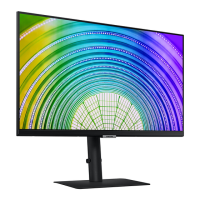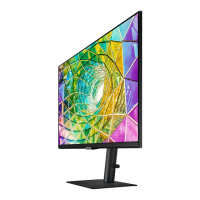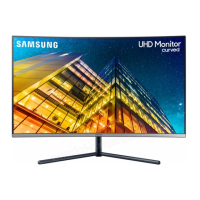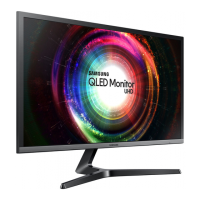Do you have a question about the Samsung S34C65 U Series and is the answer not in the manual?
Critical warnings and guidance for safe product usage and potential hazards.
Guidelines for safe electrical connections and handling to prevent shock or damage.
Procedures and precautions for physically setting up the product.
Instructions and warnings related to the normal use of the product.
Steps and precautions for cleaning the product's exterior and interior.
Recommendations for maintaining good posture while using the monitor.
Step-by-step guide for assembling the monitor stand.
Essential safety measures and handling tips when relocating the monitor.
Guidelines for ensuring adequate ventilation space around the monitor.
Instructions for adjusting the monitor's angle and vertical position.
Information on securing the product using an anti-theft locking device.
Details and requirements for mounting the monitor using a VESA bracket.
Overview of the monitor's physical buttons and their functions.
Explanation of quick access menu options via direct key functions.
Description of all available input and output ports on the monitor.
Instructions for connecting a PC to the monitor via various cables.
Guide for connecting audio output devices to the monitor.
Instructions for connecting the monitor to a power source.
How to use the monitor's USB ports as a hub for PC connectivity.
Setup guide for using the monitor's built-in camera.
Configuration steps for Windows Hello facial recognition login.
Methods for organizing and managing connected cables.
Guidance on setting the monitor to its best resolution for clarity.
Compatibility information for graphics cards with HDR10 support.
Settings for adjusting display quality, including modes and color.
Selection of preset picture quality modes for different viewing environments.
Adjustment of the screen's overall brightness level.
Adjustment of the difference between light and dark areas of the image.
Control over the clarity of image outlines.
Settings for adjusting color saturation levels.
Adjustment of the green and red color balance.
Automatic contrast adjustment for bright and dark areas.
Adjusts brightness based on HDR content for better contrast.
Selection of a preferred color tone for viewing.
Adjustment of color temperature for white objects.
Adjustment of the mid-level luminance for image depth.
Controls the brightness of dark areas in images.
Configuration of color space settings for screen display.
Selection of the color range to be displayed.
Automatically adjusts brightness for optimal screen contrast.
Optimizes HDMI picture contrast by adjusting the black level.
Accelerates panel response rate for vivid video playback.
Selection of the picture size and aspect ratio displayed on screen.
Fine-tuning of screen position for optimal viewing.
Restores all picture settings to factory defaults.
Features designed to enhance viewing comfort and reduce eye strain.
Optimizes picture quality based on lighting and content.
Sets the minimum brightness for the monitor screen.
Optimizes picture quality for eye relaxation.
Multi-screen display modes for viewing multiple sources simultaneously.
Enables or disables Picture-in-Picture/Picture-by-Picture modes.
Selects the size and aspect ratio of the sub-screen.
Options for selecting the sub-screen display size.
Allows selection of the sub-screen's position on the display.
Selects the input source for each screen in PIP/PBP mode.
Sets the screen from which audio output is heard.
Switches USB sources within PIP/PBP mode.
Adjusts aspect ratio for sub-screens in PIP/PBP mode.
Adjusts contrast for sub-screens in PIP/PBP mode.
Settings for customizing the appearance and behavior of on-screen menus.
Adjusts the transparency level of menu windows.
Controls the horizontal and vertical placement of menu windows.
Sets the display language for the on-screen menu.
Configures how long the menu window remains visible.
Shows the remaining time until the menu window disappears.
Increases the size of the on-screen menu area.
General system settings and feature configurations.
Eliminates screen tearing and lag for smoother gaming.
Reduces power consumption by adjusting brightness settings.
Adjusts the audio volume level of the monitor.
Configures USB ports for video source assignment.
Manages automatic power-off settings for energy saving.
Sets the input mode for PC or AV devices.
Selects the DisplayPort version for optimal connectivity.
Selects the HDMI version for optimal connectivity.
Automatically switches to a new connected source.
Switches to a new device connected via USB-C port.
Controls the response rate of buttons when pressed.
Configures the behavior of the power indicator LED.
Provides options to customize display for users with special needs.
Configures USB-C resolution and data transfer speed.
Assigns a chosen function to a custom key.
Optimizes brightness in real-time based on ambient lighting.
Sets the minimum brightness for the monitor screen.
Enables maximum power saving by turning off Ethernet.
Software for partitioning the screen into multiple sections.
Potential issues and limitations during software installation.
Minimum hardware and OS requirements for software installation.
Process for installing necessary device drivers for optimal performance.
Steps to take before contacting customer support for assistance.
How to perform self-diagnosis for screen-related problems.
Steps to verify and set optimal screen resolution and refresh rate.
General troubleshooting checks for common issues.
Solutions for various problems related to the display screen.
Troubleshooting steps for no sound or low volume problems.
Guidance for resolving issues related to external source devices.
Frequently asked questions and their answers for common queries.
Overview of the product's general technical specifications.
Table detailing supported signal resolutions, frequencies, and timings.
Conditions under which service fees may be charged.
Situations not considered product defects for service purposes.
Scenarios of product damage due to customer actions.
Other conditions that may incur service charges.
Detailed explanation of FreeSync technology and its compatibility.
Critical warnings and guidance for safe product usage and potential hazards.
Guidelines for safe electrical connections and handling to prevent shock or damage.
Procedures and precautions for physically setting up the product.
Instructions and warnings related to the normal use of the product.
Steps and precautions for cleaning the product's exterior and interior.
Recommendations for maintaining good posture while using the monitor.
Step-by-step guide for assembling the monitor stand.
Essential safety measures and handling tips when relocating the monitor.
Guidelines for ensuring adequate ventilation space around the monitor.
Instructions for adjusting the monitor's angle and vertical position.
Information on securing the product using an anti-theft locking device.
Details and requirements for mounting the monitor using a VESA bracket.
Overview of the monitor's physical buttons and their functions.
Explanation of quick access menu options via direct key functions.
Description of all available input and output ports on the monitor.
Instructions for connecting a PC to the monitor via various cables.
Guide for connecting audio output devices to the monitor.
Instructions for connecting the monitor to a power source.
How to use the monitor's USB ports as a hub for PC connectivity.
Setup guide for using the monitor's built-in camera.
Configuration steps for Windows Hello facial recognition login.
Methods for organizing and managing connected cables.
Guidance on setting the monitor to its best resolution for clarity.
Compatibility information for graphics cards with HDR10 support.
Settings for adjusting display quality, including modes and color.
Selection of preset picture quality modes for different viewing environments.
Adjustment of the screen's overall brightness level.
Adjustment of the difference between light and dark areas of the image.
Control over the clarity of image outlines.
Settings for adjusting color saturation levels.
Adjustment of the green and red color balance.
Automatic contrast adjustment for bright and dark areas.
Adjusts brightness based on HDR content for better contrast.
Selection of a preferred color tone for viewing.
Adjustment of color temperature for white objects.
Adjustment of the mid-level luminance for image depth.
Controls the brightness of dark areas in images.
Configuration of color space settings for screen display.
Selection of the color range to be displayed.
Automatically adjusts brightness for optimal screen contrast.
Optimizes HDMI picture contrast by adjusting the black level.
Accelerates panel response rate for vivid video playback.
Selection of the picture size and aspect ratio displayed on screen.
Fine-tuning of screen position for optimal viewing.
Restores all picture settings to factory defaults.
Features designed to enhance viewing comfort and reduce eye strain.
Optimizes picture quality based on lighting and content.
Sets the minimum brightness for the monitor screen.
Optimizes picture quality for eye relaxation.
Multi-screen display modes for viewing multiple sources simultaneously.
Enables or disables Picture-in-Picture/Picture-by-Picture modes.
Selects the size and aspect ratio of the sub-screen.
Options for selecting the sub-screen display size.
Allows selection of the sub-screen's position on the display.
Selects the input source for each screen in PIP/PBP mode.
Sets the screen from which audio output is heard.
Switches USB sources within PIP/PBP mode.
Adjusts aspect ratio for sub-screens in PIP/PBP mode.
Adjusts contrast for sub-screens in PIP/PBP mode.
Settings for customizing the appearance and behavior of on-screen menus.
Adjusts the transparency level of menu windows.
Controls the horizontal and vertical placement of menu windows.
Sets the display language for the on-screen menu.
Configures how long the menu window remains visible.
Shows the remaining time until the menu window disappears.
Increases the size of the on-screen menu area.
General system settings and feature configurations.
Eliminates screen tearing and lag for smoother gaming.
Reduces power consumption by adjusting brightness settings.
Adjusts the audio volume level of the monitor.
Configures USB ports for video source assignment.
Manages automatic power-off settings for energy saving.
Sets the input mode for PC or AV devices.
Selects the DisplayPort version for optimal connectivity.
Selects the HDMI version for optimal connectivity.
Automatically switches to a new connected source.
Switches to a new device connected via USB-C port.
Controls the response rate of buttons when pressed.
Configures the behavior of the power indicator LED.
Provides options to customize display for users with special needs.
Configures USB-C resolution and data transfer speed.
Assigns a chosen function to a custom key.
Optimizes brightness in real-time based on ambient lighting.
Sets the minimum brightness for the monitor screen.
Enables maximum power saving by turning off Ethernet.
Software for partitioning the screen into multiple sections.
Potential issues and limitations during software installation.
Minimum hardware and OS requirements for software installation.
Process for installing necessary device drivers for optimal performance.
Steps to take before contacting customer support for assistance.
How to perform self-diagnosis for screen-related problems.
Steps to verify and set optimal screen resolution and refresh rate.
General troubleshooting checks for common issues.
Solutions for various problems related to the display screen.
Troubleshooting steps for no sound or low volume problems.
Guidance for resolving issues related to external source devices.
Frequently asked questions and their answers for common queries.
Overview of the product's general technical specifications.
Table detailing supported signal resolutions, frequencies, and timings.
Conditions under which service fees may be charged.
Situations not considered product defects for service purposes.
Scenarios of product damage due to customer actions.
Other conditions that may incur service charges.
Detailed explanation of FreeSync technology and its compatibility.
| Screen Size | 34 inches |
|---|---|
| Resolution | 3440 x 1440 |
| Panel Type | VA |
| Refresh Rate | 100 Hz |
| Aspect Ratio | 21:9 |
| Brightness | 300 cd/m² |
| Contrast Ratio | 3000:1 |
| VESA Mount Compatible | Yes |
| Curvature | 1800R |
| Color Support | 16.7 Million |
| VESA Mount | 100 x 100 mm |
| Connectivity | HDMI, DisplayPort |
| Viewing Angle | 178°/178° |
| Response Time | 4 ms (GtG) |












